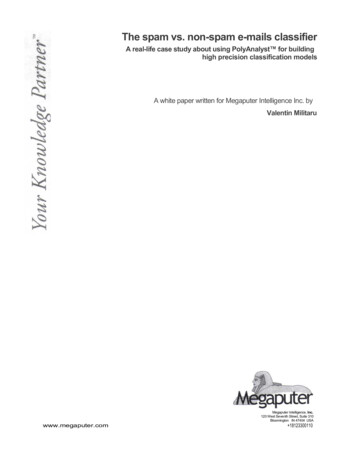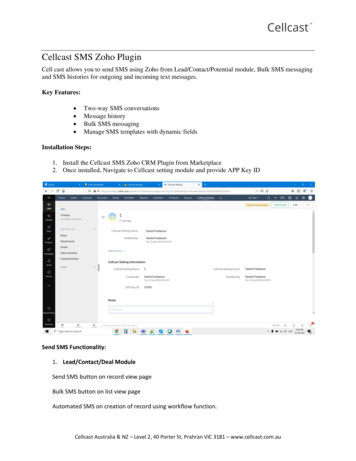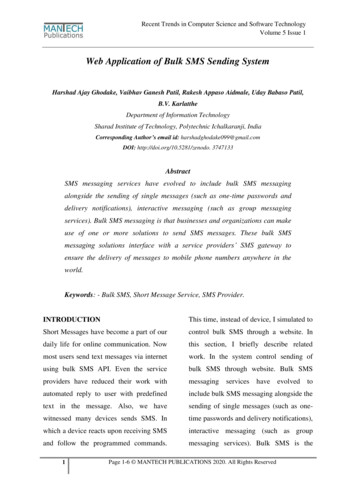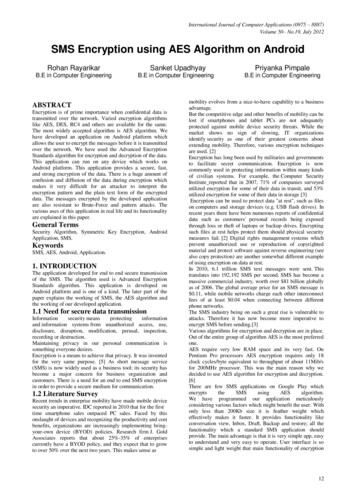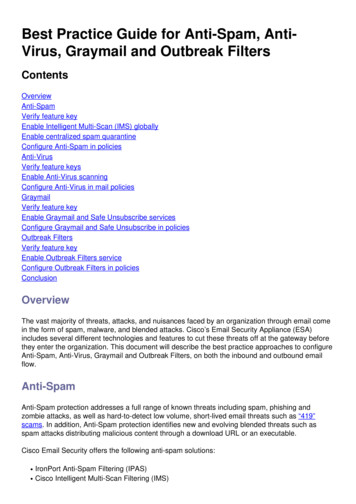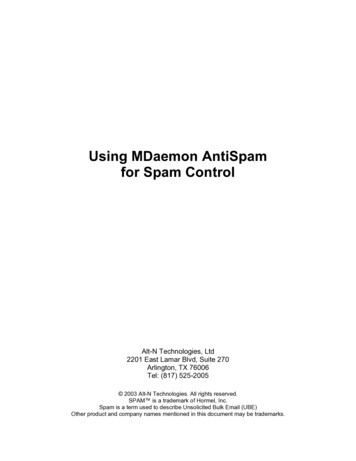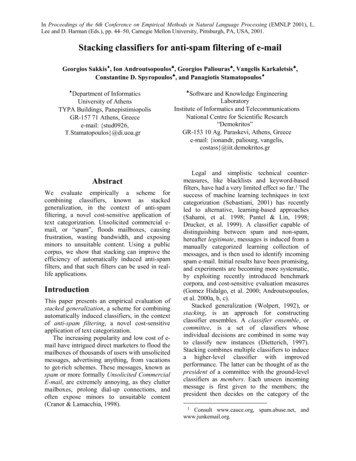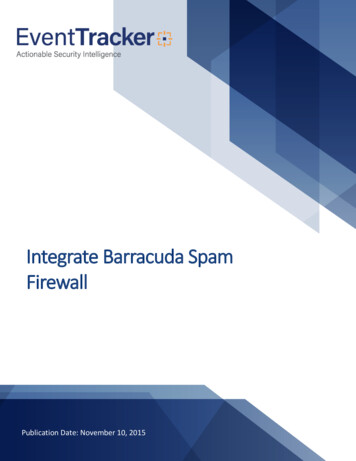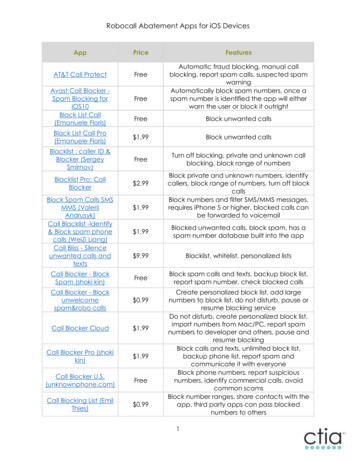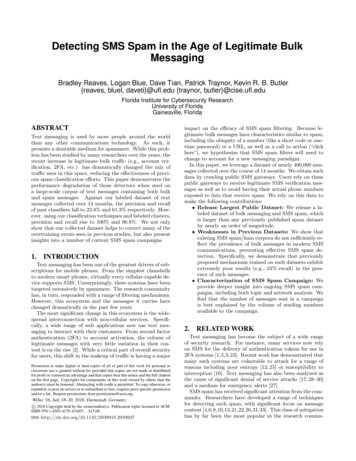
Transcription
Detecting SMS Spam in the Age of Legitimate BulkMessagingBradley Reaves, Logan Blue, Dave Tian, Patrick Traynor, Kevin R. B. Butler{reaves, bluel, daveti}@ufl.edu {traynor, butler}@cise.ufl.eduFlorida Institute for Cybersecurity ResearchUniversity of FloridaGainesville, FloridaABSTRACTText messaging is used by more people around the worldthan any other communications technology. As such, itpresents a desirable medium for spammers. While this problem has been studied by many researchers over the years, therecent increase in legitimate bulk traffic (e.g., account verification, 2FA, etc.) has dramatically changed the mix oftraffic seen in this space, reducing the effectiveness of previous spam classification efforts. This paper demonstrates theperformance degradation of those detectors when used ona large-scale corpus of text messages containing both bulkand spam messages. Against our labeled dataset of textmessages collected over 14 months, the precision and recallof past classifiers fall to 23.8% and 61.3% respectively. However, using our classification techniques and labeled clusters,precision and recall rise to 100% and 96.8%. We not onlyshow that our collected dataset helps to correct many of theovertraining errors seen in previous studies, but also presentinsights into a number of current SMS spam campaigns.1.INTRODUCTIONText messaging has been one of the greatest drivers of subscriptions for mobile phones. From the simplest clamshellsto modern smart phones, virtually every cellular-capable device supports SMS. Unsurprisingly, these systems have beentargeted extensively by spammers. The research communityhas, in turn, responded with a range of filtering mechanisms.However, this ecosystem and the messages it carries havechanged dramatically in the past few years.The most significant change in this ecosystem is the widespread interconnection with non-cellular services. Specifically, a wide range of web applications now use text messaging to interact with their customers. From second factorauthentication (2FA) to account activation, the volume oflegitimate messages with very little variation in their content is on the rise [2]. While a critical part of overall securityfor users, this shift in the makeup of traffic is having a majorPermission to make digital or hard copies of all or part of this work for personal orclassroom use is granted without fee provided that copies are not made or distributedfor profit or commercial advantage and that copies bear this notice and the full citationon the first page. Copyrights for components of this work owned by others than theauthor(s) must be honored. Abstracting with credit is permitted. To copy otherwise, orrepublish, to post on servers or to redistribute to lists, requires prior specific permissionand/or a fee. Request permissions from permissions@acm.org.WiSec’16, July 18–20, 2016, Darmstadt, Germany.c 2016 Copyright held by the owner/author(s). Publication rights licensed to ACM.ISBN 978-1-4503-4270-4/16/07. . . 15.00DOI: http://dx.doi.org/10.1145/2939918.2939937impact on the efficacy of SMS spam filtering. Because legitimate bulk messages have characteristics similar to spam,including the ubiquity of a number (like a short code or onetime password) or a URL, as well as a call to action (“clickhere”), we hypothesize that SMS spam filters will need tochange to account for a new messaging paradigm.In this paper, we leverage a dataset of nearly 400,000 messages collected over the course of 14 months. We obtain suchdata by crawling public SMS gateways. Users rely on thesepublic gateways to receive legitimate SMS verification messages as well as to avoid having their actual phone numbersexposed to lists that receive spam. We rely on this data tomake the following contributions: Release Largest Public Dataset: We release a labeled dataset of bulk messaging and SMS spam, whichis larger than any previously published spam datasetby nearly an order of magnitude. Weaknesses in Previous Datasets: We show thatexisting SMS spam/ham corpora do not sufficiently reflect the prevalence of bulk messages in modern SMScommunications, preventing effective SMS spam detection. Specifically, we demonstrate that previouslyproposed mechanisms trained on such datasets exhibitextremely poor results (e.g., 23% recall) in the presence of such messages. Characterization of SMS Spam Campaign: Weprovide deeper insight into ongoing SMS spam campaigns, including both topic and network analysis. Wefind that the number of messages sent in a campaignis best explained by the volume of sending numbersavailable to the campaign.2.RELATED WORKText messaging has become the subject of a wide rangeof security research. For instance, many services now relyon SMS for the delivery of authentication tokens for use in2FA systems [1,5,9,23]. Recent work has demonstrated thatmany such systems are vulnerable to attack for a range ofreasons including poor entropy [12, 25] or susceptibility tointerception [16]. Text messaging has also been analyzed asthe cause of significant denial of service attacks [17, 28–30]and a medium for emergency alerts [27].SMS spam has received significant attention from the community. Researchers have developed a range of techniquesfor detecting such spam, with significant focus on messagecontent [4,6,8,10,13,21,22,26,31,33]. This class of mitigationhas by far been the most popular in the research commu-
Cell CarriersESMEGatewayPublicGatewayWebServicesFigure 1: A high-level overview of the SMS ecosystem.nity as collecting SMS spam can be done without specialaccess to carrier-level data. The research community hasrelied almost exclusively on publicly available datasets, likethose made available by Chen and Kan [7] or Almeida etal. [4]. Unfortunately, these datasets are quite limited, withonly a few hundred actual spam messages. Other effortshave instead focused on network behaviors, such as volumes,sources and destinations [11,14,15,18–20,32]. Unfortunately,this latter class of analysis is generally limited to networkproviders, making independent validation difficult.3.BACKGROUNDText messaging within the traditional closed telephonyecosystem works as follows: a user generates a messageon their phone and transmits it to their local base station,which delivers the SMS to the Short Messaging Service Center (SMSC). With the aid of other nodes in the network, theSMSC forwards the SMS to its destination for delivery.Modern telephony networks accept text messages from afar larger set of sources. In addition to the SMSC receivingtext messages from users served by other cellular providers,many VoIP providers (e.g., Vonage, Google Voice) also allow their users to send text messages. Messaging apps transported by Over the Top (OTT) connections now deliver messages via the public Internet. Lastly, a wider range of External Short Messaging Entities (ESMEs) such as web servicesused for two-factor authentication (e.g., Google Authenticator, Duo Security). Within this class also lies entities knownas Public Gateways. These public websites allow anyone toreceive a text message online by publishing telephone numbers that can receive text messages, and posting such messages to the web when they are received. These services arecompletely open — they require no registration or login, andit is clear to all users that any message sent to the gatewayis publicly available.It is through these Public Gateways that we are able toconduct our measurement study. Because these interfacespublish text messages for destinations that span a range ofproviders and continents, our work provides the first globalpicture into SMS spam (especially that which bypasses thespam filters of providers).4.DATA CHARACTERIZATIONThis paper makes use of several previously compiled datasets.First, we use two existing SMS spam and ham corpora. Weuse a spam corpus compiled by Almeida and Hidalgo [4] thatcontains 747 messages. For legitimate messages, we use acorpus of 55,835 messages collected by Chen and Kan [7]from submissions of personal text messages from volunteers.We refer to these two corpora as the “public corpus.” Tothe best of our knowledge, these messages are the largestpublicly available collection of SMS ham and spam.Many of the insights of this paper are made possible bya collection of SMS from another source: public SMS gateways. Public SMS gateways are websites that purchase apublic phone number and post all text messages receivedby that number to a public website visible to anyone. Thesewebsites claim to exist for various reasons, including to avoidSMS spam by not revealing a user’s true phone number,but the majority of messages (over 67.6%) received by thesegateways consist of account verification requests or one-timepasswords (i.e., legitimate bulk SMS). This means that themessage type distribution of our data may not be representative of messages seen by a traditional mobile carrier. Eventhough this data may have fewer personal messages thantypical, it is still a valuable data source for understandingthe effects of bulk messaging on SMS spam classification.These gateways provide complete message content, senderand receiver numbers, and the time of message. The messagedata that we use was collected by scraping these websites,resulting in a dataset of 386,327 messages sent to over 400numbers in 28 countries over a period of 14 months. Manyof these messages are duplicates, or are syntactically or semantically identical (e.g., “Hello Alice” and “Hello Bob”).In a prior study [25], this data was grouped by orderingmessages lexically and identifying boundaries where Levenshtein distance fell below 90%. The largest of these groupswere manually labeled to identify message intent, including indicating if a message appeared to be unsolicited bulkadvertising (i.e., spam). Only 1.0% of this labeled data consisted of spam messages. Note that messages sent by individuals are systematically excluded from analysis becausethey are not self-similar and do not form large groups.For our experiments, we carved the gateway data into twodistinct datasets. The first was one message from every labeled group (called “labeled gateway data”). This datasetis intended to train a machine learning classifier, and accordingly overwhelmingly similar messages are removed toavoid overfitting the classifier. This dataset consists of 754messages, including 31 (4.1%) spam messages. The seconddataset was all messages that were previously unlabeled,called the “unlabeled gateway data”. This dataset consistsof 99,363 messages of an unknown mixture of personal messages, legitimate bulk messages, and spam.We have released both the labeled gateway training dataand confirmed spam discovered in the unlabeled gatewaydataset (details provided in subsequent sections). This datasetcontains 1316 unique bulk messaging ham messages and5673 spam messages. It is available at http://www.sms-analysis.org.Ethical Considerations We note that there are ethicalquestions that must be considered in collecting this data.First, the data is publicly available, and therefore underUnited States regulations an institutional review board doesnot need to oversee experiments that collect or use this data.Furthermore, we note that users who expect to receive messages at these messages are aware that they will be publicly available, and accordingly must reasonably have lowprivacy expectations. However, senders of messages maynot be aware that these messages will be public. Because ofthis, we seek to focus our use of this data on bulk messaging,where message content is unlikely to be confidential to either
Table 1: Classifier 1%88.8%0.1%0.1%PLGW23.8%61.3%8.1%1.6%P LGWLGW100%96.8%0.0%0.1%P LGWUGW84.6%—1.3%—Key: P — Public Corpora, LGW — Labeled Gateway Data, UGW — UnlabeledGateway Datathe sender or recipient. Our methods are designed so thatwe systematically exclude messages between individuals,and in the event that any personally identifiable information (PII) is disclosed, we do not further analyze, extract,or make use of that information in any way. We note thatany PII in this data was already publicly leaked before wecollect and analyze it, so our use of this data does not further damage any individual’s privacy. Finally, our corporahave been scrubbed of personally identifiable informationby replacing sensitive information with fixed constants. Wereplaced every instance of names, physical addresses, emailaddresses, phone numbers, dates/times, usernames, passwords, and URLs that contain potentially unique paths orparameters. Every released message was examined by tworesearchers.5.EVALUATING SMS SPAM CLASSIFIERSAs discussed in earlier sections, prior SMS spam corporawere collected by researchers who solicit volunteers to provide examples of SMS spam or legitimate messages. Webelieve that these corpora, under which the bulk of SMSspam research has been conducted, are fundamentally limited. For example, SMS has increasingly become a means ofcontact for many online services to provide information tousers and to provide security related services like two-factorauthentication. However, the existing corpora for SMS spamresearch do not account for such messages. Accordingly,we hypothesize that existing SMS spam detection researchbased on the corpora available will fail to accurately classifylegitimate messages as benign.We designed several experiments to test this hypothesis.The following subsections detail these experiments and theirfindings. Existing literature on machine learning for contentbased SMS spam classification has exhaustively examinedchoices of machine learning algorithm [8] and feature selection [26], finding that while there is an optimal-accuracydesign, other choices lead to only minor degradations in performance. We then implement and evaluate this classifieragainst gateway data to evaluate the effect of the spam corpus on the detection of SMS spam in the face of legitimatebulk messaging. Our aim in doing so is demonstrate theimpact on spam classification of changes in legitimate SMSmessaging, not to establish an empirically optimal classifier.We conclude by retraining and applying this classifier toidentify SMS spam in unlabeled gateway data.5.1Classifier Selection and ImplementationTo evaluate the question of how bulk SMS would be classified, we needed to implement an SMS spam classifier. Afterreviewing the literature, we found that the best performingclassifiers (taking into account accuracy, precision, and recallon cross-validated evaluation) use a support vector machine(SVM) [8]. SVM classifiers permit the use of kernels thatallow an expansion of input data into a higher-dimensionalspace to improve classification performance. The kernelsused in prior work were unspecified, so we use a linear kernel as it is the simplest possible kernel. We confirmed thisprovided the best performance compared to other kernels,but omit a full analysis for space reasons. Regarding features, prior work has investigated a naive binary bag-ofwords model, using only counts of keywords common inspam, n-grams, and more complicated feature sets. Priorwork found that a simple binary vector indicating the presence of a word in the message performed best [26], so we alsouse this approach. Like Tan et al. [26], we preprocess thedata to remove features that could induce classification onnon-semantically meaningful features, including making allwords lower case and replacing all URLs, email addresses,stand-alone numbers, and English days of the week with afixed string. As in prior work, we do not remove stop words1from the feature vector. We use the scikit-learn Python library [24] for feature analysis and classifier implementation.Several other classifiers were evaluated using a variety offeature selection techniques. We found that results wereconsistent with those found in prior work, and omit furtherdiscussion for space.With this classifier implemented, we train the classifierand evaluate its performance on the existing public corpora,then train and test the classifier using 5-fold cross validationto ensure consistency with previous work. The vocabularyin this dataset results in a feature vector with 39,558 words.After training, we see an overall accuracy of 99.8%. Precision (a measure of how many messages identified as spamare actually spam) was 94.1%, while recall (a measure ofhow much spam was correctly identified) was 88.8%. Theseresults are consistent with the findings of Tan et al. [26], whofound an F1 score of 93.6%, comparable to our classifier’sF1 score of 91.4%. In summary, the classifier performanceseems quite good.5.2Evaluating Classifier with Training DataHaving trained and validated a classifier, we can test ourhypothesis that the classifier will fail to properly categorizelegitimate bulk SMS messages, instead labeling it as spam.After classifying the data, we find that the classifier’s performance significantly declines, confirming our hypothesis.Precision falls from 94.1% to 23.8%. Recall also declinedfrom 88.8% to 61.3%. The practical impact of this classifier’s poor performance on the user is best reflected by theoverall false positive rate. In total, 8.1% of legitimate bulkmessages would be miscategorized by the classifier, providing a frustrating user experience. In particular, droppingaccount verification messages will make new services inaccessible, and dropping SMS authentication messages wouldmake services effectively unavailable for users.To understand these results, we investigated the featureweights learned by our classifier. Feature weights indicatethe relative importance of a particular feature in determining if a message is spam; positive weights indicate that afeature is indicative of spam, while weights close to 0 do notstrongly indicate spam or ham. For example, the featureindicating the presence of a number has a weight of 0.637,while the word “rain” has a weight of -0.628. This indicatesthat the presence of a number (like a phone number or aprice) is a strong indicator of “spamminess.”1Stop words are extremely common words, like “the”, “and”, etc.,often removed during natural language data analysis.
To better understand our false positives, we examined theweights of the 20 most frequent words in our false positives.We find that words that are prevalent in legitimate bulk SMSlike “code” or “verify” have weights with low absolute value(0.046 and 0.000 for these words). The words that are frequently used in these messages have weights that contributealmost nothing to the decision of the classifier.As a result, the following message from the GW dataset ismislabeled as spam due to the effect of large positive weightsprovided by the features “has number” and “has URL.”WhatsApp code 351-852. You can also tap onthis link to verify your phone:v.whatsapp.com/3518525.3Evaluating Classifier on Labeled DataMachine learning classifier performance is governed bymany factors regarding model selection; however, experienceshows that small datasets are often a bottleneck for classifierperformance [3]. We hypothesized that better data, not abetter model, was required to rectify the performance issueswe found. To test this hypothesis, we retrain the classifiermentioned above to include the labeled gateway messages.After running a cross validation analysis, we find that classifier performance increases to numbers comparable or better than those in the first experiment. We see an overallaccuracy of 99.9%, with precision and recall of 100% and96.8%. It is thus possible to distinguish legitimate and unsolicited bulk messages, at least in a cross-validation setting.We again examined the feature weights of our messages,and we found that the features like “code” and “verify” haveacquired strong weights: -0.402 and -0.706 respectively. Thisshows that the public corpus fails to provide enough datasamples to fully cover the domain of legitimate messages,but this can be rectified using gateway data.5.4Evaluating classifier on unlabeled dataWhile cross validation is a standard technique for evaluating a classifier given a finite data set, it loses predictivevalue compared to using a true testing data set. To furtherevaluate our new retrained-classifier, we apply it to 99,363unlabeled gateway messages. Because our gateway labeling data focused on messages that were highly similar orrepeated to a high degree, we felt confident that there wasspam in the unlabeled data as well.To evaluate the new retrained classifier, we classified thesemessages, finding 8179 messages of unlabeled gateway data(8.2%) labeled as spam by the classifier. However, this doesnot tell us how many messages are legitimate bulk messages (i.e. false positives) and many are actually unsolicited.To answer this question, we manually label the messagesmarked as spam by our classifier.Fortunately, many of these messages are similar in content, so they can be grouped together to label them. Tofacilitate clustering, we describe each message using a common technique in text data known as latent semantic analysis (LSA). LSA describes high dimensional text data asa low-dimensional feature vector that groups semanticallysimilar messages together. LSA computes a term frequency– inverse document frequency matrix of the corpus, thenapplies a singular value decomposition to select the mostimportant singular vectors, reducing the document space.We then cluster documents using the DBSCAN clusteringFigure 2: The top spam categories in gateway dataalgorithm. DBSCAN identifies clusters by specifying a minimum cluster density and finding elements that form regionswith density greater than the threshold. Unlike k-means, itdoes not make assumptions about cluster shape, or the number of clusters. After clustering, we identified 475 clustersof spam in the gateway data. We evaluate the effectivenessof our clustering algorithm by computing the average silhouette score of each message. Briefly, this score indicatesthe similarity of objects within each cluster (as opposed to aneighboring cluster), and our score of 0.644 indicates a goodclustering structure. We characterize these clusters in moredetail in the following section.We then manually labeled these clusters for topic (e.g.,pharma, payday loans, etc.) and whether the messages wereactually spam (e.g., false positives). Unfortunately, determining if a message is solicited is not a perfect science, andthere are some limitations to this approach. First and foremost, a message sent to some users may be solicited whilethe same message sent to others could be unwanted by others. Furthermore, we were not the intended recipients ofthese messages, and in some messages context is not alwaysavailable to us when labeling. In situations where doubt waswarranted, we erred on the side of assuming a message wasindeed solicited (i.e. not spam). For example, we labeledany message as “not spam” if it seemed to be the responseto a user inquiry or if it seemed to be part of an exchange inwhich a user could have prompted the message. Therefore,we believe that our reported results are conservative. Second, we ignore messages that were not clustered, so groundtruth is unavailable for 13.1% of messages labeled as spam.Additionally, we did not have the resources to examine messages that were not classified as spam. Therefore, we cannotdefinitively measure recall or false negatives.With labeled classification results, we can evaluate theperformance of a SMS spam classifier trained with awareness of legitimate bulk messages. We found in total that1261 messages appeared to be messages that could havebeen legitimate bulk messages. This corresponds to a corresponding precision of 84.6% – a substantial increase overthe expected 23.8% that would be seen without training forlegitimate bulk messages. This classifier also drastically reduces the false positive rate. We see a false positive rate ofonly 1.3% as opposed to the earlier 8.1%.6.CLUSTERED SPAM DATAThe previous section described how it is necessary to include legitimate bulk messages in order to effectively classifymessages from a modern SMS corpus. Those experimentsproduced a labeled dataset of over 8179 labeled messagesgrouped into 475 clusters, and this set provides a great example of the utility of using public data to develop contentbased SMS spam classifiers. In this particular case, this dataset is unique because it spans many countries, carriers, and
(a) Sender Vol. vs Message Vol.(b) Sender Vol. vs Lifetime(c) Message Vol. vs LifetimeFigure 3: Campaign message volume is strongly correlated with sending message volume, while campaign lifetime is lessrelated to the amount of messages sent or numbers used by a campaign.months of time, unlike prior works that have studied onlyvictim-submitted messages or spam in a single network.6.1Content AnalysisThe gateway data included source and destination phonenumbers. We used the Twilio phone number lookup serviceto provide information on the destination phone numbers(i.e. numbers controlled by the gateways), including thedestination country and carriers. The United Kingdom received an overwhelming majority of the spam messages —72.1%. This is even a disproportionate share consideringthat the UK received only 11.4% of the total messages inthe gateway dataset. Australia, China, and Belgium alsohad disproportionally high spam message volumes as well.These clusters were categorized into 18 distinct categories,and the top 10 categories are also shown in Figure 2. Messages offering payday loans or other forms of credit comprised 41.3% of all labeled spam in this message — dwarfingall other categories. Following loan spam was job advertisingmessages. 97.5% of these messages — 827 — were sent froma single number in a 7 hour period. Each message was personalized with a unique name and address; we believe thatthese messages were sent to a gateway as a test run for abulk messenger service before sending the messages to theirintended recipients. Because gateways collect a number ofaccount verification requests, it was unsurprising to find advertising for telephony services (“obtain a phone number”)or phone verification services. We also found the standardcontests, online gambling opportunities, and a small number (57) of adult-oriented services common in spam data.However, we did find some more interesting schemes. Oneexample was messages claiming to offer refunds or payoutsfor reasons as varied as unclaimed tax refunds, unclaimedinjury settlements, or unfairly levied bank fees.6.2Network AnalysisBy combining content analysis with network features likesending numbers, we can gain additional insights into SMSspam activity not available to earlier studies. In particular, we can study the activity of a given spam campaign —messages that may come from many different phone numbers but delivering a similar message to many users. For ouranalysis, we treat each spam cluster as a campaign. Thesecampaigns are extensive in scope. They can have lifetimesof over a year (402 days) with a median lifetime of 53 days,transmit messages to up to 12 countries, and send from upto 80 numbers with a median of 5.We hypothesized that if networks take any sort of proactive measure to prevent nuisance bulk messaging, that spamcampaigns with high message volumes and long lifetimeswould need to use many sending numbers to deliver highmessage volumes over time. We also hypothesized that longlived campaigns would have have high message volumes.Figure 3c visualizes the relationship between these variables,with each data point representing a single spam campaign.We also compute the Spearman correlation coefficients2 between these variables. As expected, we found that the message volume and the number of sending phone numbers wasstrongly correlated (ρ 0.761), as shown in Figure 3a. Surprisingly, we found a lower correlation (ρ 0.530) betweenmessage volume and campaign lifetime; as shown in Figure 3b, low-volume campaigns are present across the lifetime range. Finally, we see that while many short-livedcampaigns have low numbers of sending messages, manylong-lived campaigns are successful using a small numberof messages. These variables also share a weak correlation(ρ 0.473). Overall, this data implies that spammers whowant to send at high volumes must use many numbers todo so, but apart from many campaigns that send only a fewmessages over a short time scale, campaign lifetime seemsunrelated to either the sending number volume nor the messaging volume.7.CONCLUSIONAs text messaging has evolved from a closed system whereevery message was generated within the cellular network toone where a wide variety of non-cellular services can sendthese messages, the nature of SMS data has substantiallychanged. The rise of legitimate bulk messages, which maysyntactically resemble spam but provide valuable servicessuch as two-factor authentication to users, means that traditional approaches to characterizing SMS spam are no longeradequate for classification. We address these problems inthis paper by releasing the largest corpus of publicly available labeled bulk messages and SMS spam. Based on ourclassification techniques, we demonstrate that compared to2Spearman correlations, represented as ρ, measure with a valuefrom 1 to 1 whether a monotonic function (not a strictly linear function, as in the case of a Pearson correlation) relates twovariables.
previous work, we raise precision across the public corpusfrom 23.8% to 100%, and raise recall from 61.3% to 96.8%.Even in the absence of manual labeling, we raise precision to84.6% with a 1.3% false positive rate compared to 8.1% using previous techniques. We also find substantial amounts ofSMS spam are related to finance, and certain countries aredisproportionately targeted by spam. Our results demonstrate that new approaches to spam cla
which delivers the SMS to the Short Messaging Service Cen-ter (SMSC). With the aid of other nodes in the network, the SMSC forwards the SMS to its destination for delivery. Modern telephony networks accept text messages from a far larger set of sources. In addition to the SMSC receiving text messages from users served by other cellular providers,


